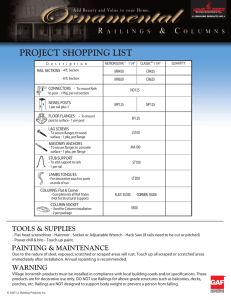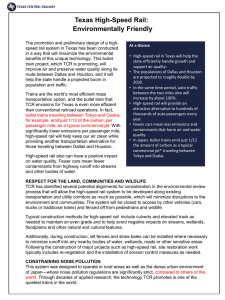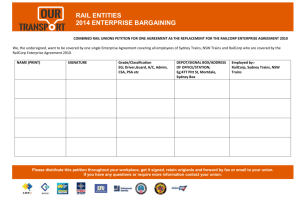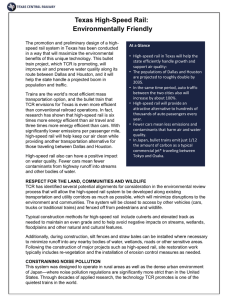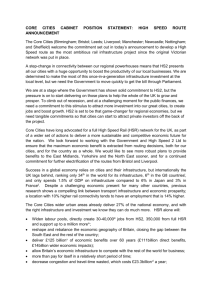Necessary Materials to Support High
advertisement
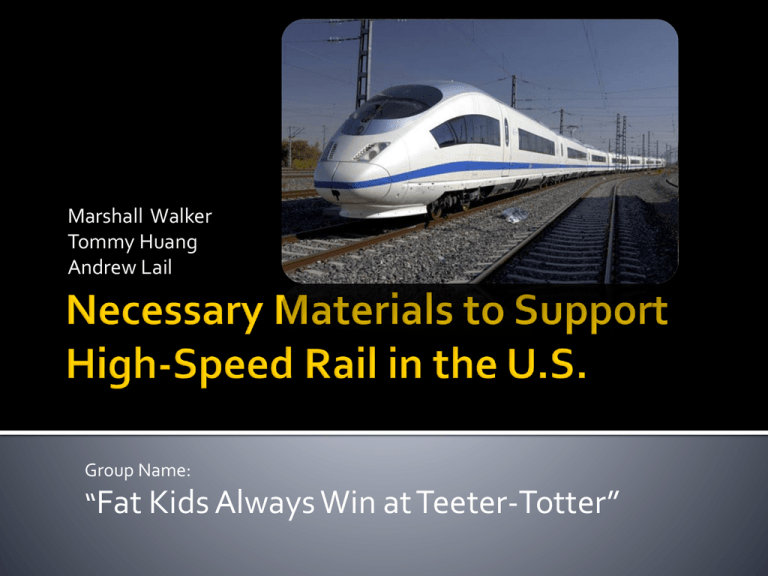
Marshall Walker Tommy Huang Andrew Lail Group Name: “Fat Kids Always Win at Teeter-Totter” The use of high-speed rail (HSR) mass transit is coming to the United States. Plans are in the works to connect Los Angeles to Las Vegas as we speak. The following slides are based on this project. Currently, high speed trains are widely used in both Europe and Asia – we are about 20 years behind in implementing a HSR system, as well as using state-of-the-art materials for the rails. Makes for a quicker + cheaper way to travel Currently, passenger trains in America average about 40 mph, but the new locomotives will be traveling around 150 mph. Many existing elements in place today will need to be modified/upgraded to support the new trains. Higher speeds means the tracks need to be banked (similar to a race track). Wood’s low resistance to compressive forces make it unsuitable for use in such applications. Vs The high-speed French train broke a world speed record, on April 3, 2007, reaching 357.2 mph near Grigny in rural, eastern France. It normally runs at 185 mph. 1. Higher strength steel High strength low alloy steel (HSLA) – [80,000 psi yield strength] - greater corrosion resistance than carbon-based steel, in addition to only being 24% more expensive than A36 steel [36,000 psi yield strength]. Carbon Fiber - provides an extremely appealing stiffness-to-weight ratio Aircraft-grade Aluminum – can withstand the forces of flying, which are comparable to HSR PVC-related plastics Resistant to corrosion 2. Can be made from recycled materials 3. Have the ability to conform to very strict tolerances 1. Currently, the majority of rails in place are A36 (very basic) stainless steel. As the speed of the train increases, the dimensional tolerances in the rails themselves decrease, so the manufacturing of the steel needs to be more precise. From a structural standpoint, not only do the rails need to be cast to higher standards, they also need to be stiffer. Higher speed = more efficiency = heavier, longer trains. •Concrete ties being constructed on a new rail line •Reinforced rail track designed to keep the trains aligned with the rail during cross-overs Arizona Japan The wooden ties used now (in the span from LA to Vegas) range in age from 15– 100 years old, since the lines were laid in 1904. Service on the line was discontinued in 1997. 92% of all the ties are made from wood Wood is used primarily because of its relative low cost to produce and the abundance of material New system that would require implementing new tracks Re-routing the lines for entire cities (keeping existing lines for freight/ hazardous materials) Electric trains will require a new electric grid Power spikes + demands (energy grants) Passenger comfort and assurance at higher speeds (culture change) New terminals to accommodate the higher speed locomotives: parking, support transportation, restaurants Habitat disturbance Financing Storage + maintenance centers for new trains Picture taken in China, 2007 •Elevate track over pre-existing rails •A newly constructed high speed rail station in Zaragoza, Spain •In 2009, 40 states applied for high speed rail grants after Pres. Obama signed the American Recovery & Reinvestment Act that put aside $8 billion dollars for high speed rail development. •Banking of the tracks •Concrete railroad ties •Rail is Elevated •Electric Grid 1. Budget 2. Existing routes? New routes 3. Elevation? Just Imagine if Columbia had elevated rails . . . Re-lining the tracks from LA to Vegas (270 miles) with high-strength steel rails would cost about $8.15 to install one foot of rail. With all the costs associated with laying ties, using railroad spikes, and installing everything else need to complete the line, the cost to lay one foot of rail is $48. This puts the cost to run the line 270 miles at $670 million. In comparison, it costs roughly $12 million to build one mile of road. The cost to build a road from LA to Vegas would be $3.2 billion. http://images.search.yahoo.com/images/view?back=http%3A%2F%2Fimages.search.yahoo.com%2Fsearch%2Fimages% 3Fp%3DHigh%2BSpeed%2Btrain%26ei%3DUTF-8%26fr%3Dyfp-t701&w=767&h=577&imgurl=www.sustainablecityblog.com%2Fwp-content%2Fuploads%2F2009%2F04%2Fhigh-speedrail-plan-usa-image.png&rurl=http%3A%2F%2Fwww.sustainablecityblog.com%2F2009%2F04%2Fobama-unveils-highspeed-rail-vision%2F&size=188KB&name=high-speed-rail...&p=High+Speed+train&oid=497ce3c1893da652b9db2562c7d5dcf4&fr2=&no=7&tt=67100&sigr=12gmg719i&sigi=12pfgv 35t&sigb=12l0sna73&.crumb=/v2XcXrpx9s http://www.elmassian.com/trains-mainmenu-27/track-mainmenu-93/track-aamp-rail-material-mainmenu-94 http://www.lvol.com/lvoleg/hist/lvhist.html Railroaddata.com http://tacnet.missouri.org/history/railroads/rrcosts.html Video of High Speed Rail http://www.youtube.com/watch?v=MmmwWI6bSE4
